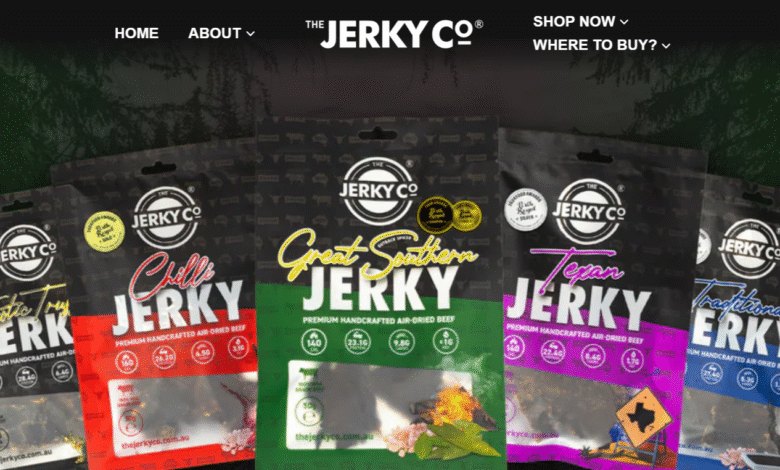The ultimate guide to the best beef jerky: flavour, texture, and beyond

There is nothing quite like a good piece of jerky. Whether you are hitting the road in the ute for a long weekend, needing a protein hit after a solid session at the gym, or just looking for a truly satisfying snack to tide you over until dinner, dried meat is the answer. But not all jerky is created equal. Far from it, in fact. For anyone who appreciates a hearty, satisfying snack, the search for the absolute best beef jerky is a lifelong pursuit, demanding attention to detail and a keen palate.
When you consider the sheer variety of premium beef jerky options available across the regions, it’s clear this isn’t just a snack; it’s an art form. We’re moving well past the chewy, overly sweetened stuff you might find at a servo. Today’s artisan producers are crafting complex, delicious flavours that elevate the experience entirely. If you want to optimise your snacking game, you need to know what to look for.
What separates good jerky from great jerky?
The difference between a mediocre dried meat snack and the truly magnificent examples of the best beef jerky usually boils down to two factors: the quality of the meat and the meticulousness of the curing process. You are looking for something that respects the natural flavour of the beef while introducing complementary spices.
The art of the cure and marinade
A great marinade is the soul of superior jerky. It’s what delivers that initial burst of flavour and helps preserve the meat. Traditional recipes often rely on a simple blend of salt, pepper, and vinegar, but modern producers experiment with everything from smoky paprika and rich Worcestershire sauce to complex chilli profiles. The quality of the ingredients matters immensely; look for natural spices and minimal artificial flavourings. Moreover, the time the beef spends soaking up that marinade is critical. A rushed job results in bland, unevenly flavoured meat, whereas a properly cured piece delivers deep, consistent flavour right through the centre.
Texture: the chew factor
Texture is perhaps the most divisive element in the jerky debate. Are you a fan of a tough, dry chew that requires some serious jaw work, or do you prefer a softer, more pliable piece? The moisture content dictates this. Finding the perfect balance is key to achieving the best beef jerky experience. If it’s too moist, it risks spoilage; if it’s too dry, it can feel like chewing shoe leather. The ideal texture offers resistance without being brittle, tearing cleanly and dissolving slowly, releasing flavour as you chew. Often, the thickness of the cut plays a role here too, with thicker strips offering a more substantial, satisfying bite.
Navigating the flavour landscape
Once you’ve nailed down the texture you prefer, it’s time to explore the vast flavour landscape. The range of options available for the best beef jerky means there is something for every palate, from the mildest traditionalists to the most hardened spice fiends.
- Traditional/Original: These are usually savoury, slightly salty, and allow the natural beef flavour to shine. They are perfect for snacking when you need pure, unadulterated meat flavour.
- Smoky & BBQ: Often featuring liquid smoke or actual wood-smoked beef, these varieties offer a robust, rich flavour reminiscent of a backyard cookout. They are a popular choice for a reason.
- Chilli & Spicy: From mild jalapeño heat to serious ghost pepper punch, spicy jerky is incredibly popular. The real genius, however, is when the heat complements the beef rather than overwhelming it. The best beef jerky with heat should offer flavour first, then fire.
- Sweet & Savoury: Think teriyaki, honey soy, or even maple. These options balance the saltiness of the cure with a touch of sweetness, creating a highly addictive flavour profile.
When you are trying to decide which flavour is right for you, consider where and when you plan to eat it. A mild, savoury option might be ideal for a long drive, while a highly flavourised, smoky variety could be the perfect accompaniment to a cold beer after a hard day’s labour.
Quality control: what to look for on the label
In the quest for the best beef jerky, turning the packet over is essential. High-quality producers prioritise real ingredients. Look for companies that minimise the use of artificial preservatives, nitrates, or excessive sugar.
A short, legible ingredient list is always a good sign. Furthermore, consider the source of the beef. Many premium brands use locally sourced, high-quality cuts. Understanding where your food comes from builds trust and confidence, ensuring you are investing in a product that not only tastes great but aligns with your values. This transparency is a hallmark of truly trustworthy and expert producers of the best beef jerky.
Making the final decision
Ultimately, determining the absolute best beef jerky is a subjective exercise. Your perfect piece might be someone else’s ‘too chewy’ or ‘not hot enough’. However, by focusing on quality meat sourcing, thoughtful curing processes, and balanced flavour profiles, you can dramatically improve your chances of finding a winning snack.
Don’t be afraid to try smaller, artisan producers. Often, the care and attention to detail in these smaller batches result in truly exceptional products. Whether you are stocking up the pantry or searching for a protein-rich snack for your next adventure, the market is overflowing with delicious options ready to be discovered. The best beef jerky is out there, waiting for you.
Frequently asked questions about beef jerky
What is the best cut of beef to use for jerky?
Producers often favour lean cuts of beef with minimal fat, as fat can spoil quickly. Common choices include top round, bottom round, or flank steak. Using lean meat ensures a longer shelf life and a better final texture.
How long does beef jerky last once the packet is opened?
While commercially packaged jerky has a long shelf life when sealed, once opened, it should ideally be consumed within one to two weeks. Always reseal the packet tightly and store it in a cool, dry place to minimise moisture exposure and maintain the quality of the best beef jerky.
Is beef jerky a healthy snack option?
Yes, beef jerky is generally a fantastic source of protein and is relatively low in fat. However, it can be high in sodium, depending on the cure. Always check the nutritional panel to ensure the sodium and sugar levels align with your dietary requirements.
Why is some jerky tougher than others?
The toughness or pliability of jerky is mainly determined by the moisture content and the thickness of the meat strips. Jerky that is dried for a longer period will be tougher and chewier, while some modern styles retain more moisture for a softer bite.
Can I make my own beef jerky at home?
Absolutely. Many enthusiasts enjoy the programme of making their own jerky using a dehydrator or a low-temperature oven. The key is ensuring food safety by heating the meat to the correct internal temperature before drying and using the proper curing salts.





